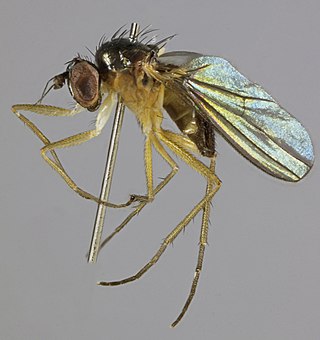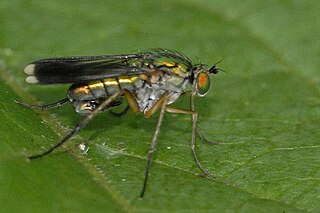
Argyra is a genus of flies in the family Dolichopodidae. The name "Argyra" comes from the Greek word for "silver".

Achalcus is a genus of flies in the family Dolichopodidae.

Anepsiomyia is a genus of flies in the family Dolichopodidae. It contains only one extant species from Europe, A. flaviventris, as well as two fossil species from the Eocene of Russia and Belarus. The systematic position of the genus is currently uncertain: it has been variously placed in subfamilies such as Sympycninae and Peloropeodinae.
Cheiromyia is a genus of flies in the family Dolichopodidae. It is found in the Neotropical realm. It was originally named Cheirocerus by Octave Parent in 1930, but was renamed to Cheiromyia by C. E. Dyte in 1980 after it was found to be preoccupied by the catfish genus Cheirocerus.

Diaphorus is a genus of flies in the family Dolichopodidae. Lyroneurus is considered by some authors to be a subgenus of this genus.
Eucoryphus is a genus of flies in the family Dolichopodidae, with three species known from the Palearctic. It is found in the Alps and the mountains of southern Corsica.

Liancalus is a genus of flies in the family Dolichopodidae. It contains at least 21 species distributed worldwide except in Australasia and Oceania. The genus includes some of the largest species in the family, with body length approaching 12 mm in some species.

Medetera is a large genus of flies in the family Dolichopodidae. It includes about 350 species worldwide. The adults are commonly found resting on vertical surfaces such as tree trunks. The larvae are predators of bark beetle larvae.

Tachytrechus is a genus of long-legged flies in the family Dolichopodidae.

Teuchophorus is a genus of flies in the family Dolichopodidae.

Thinophilus is a genus of flies in the family Dolichopodidae. It includes about 146 described species distributed worldwide. Most species of the genus are found in coastal habitats, while a few species are found in freshwater habitats.

Hydrophorinae is a subfamily of flies in the family Dolichopodidae. Several studies have found evidence that the subfamily in its current sense is polyphyletic.

Dolichopodinae is a subfamily of flies in the family Dolichopodidae.

Diaphorinae is a subfamily of flies in the family Dolichopodidae.

Peloropeodinae is a subfamily of flies in the family Dolichopodidae. In some classifications, the genera of the subfamily are included in Sympycninae. According to Germann et al. (2011), the subfamily is polyphyletic.
Paraphrosylus is a genus of flies in the family Dolichopodidae. It is distributed along rocky coasts of the Eastern Pacific, and members of the genus live in the intertidal zone. Paraphrosylus was originally established as a subgenus of Aphrosylus, but was later raised to genus rank.

Poecilobothrus is a genus of flies in the family Dolichopodidae.
Lyroneurus is a genus or subgenus of flies in the family Dolichopodidae. Its rank is not currently certain; it has variously been placed as its own genus or as a subgenus of Diaphorus. More recently, it has been suggested by Pollet et al. (2004) to be a synonym of Chrysotus, but some authors maintain generic rank noting that Chrysotus is possibly paraphyletic.













